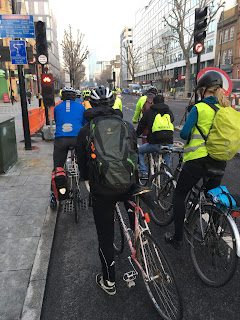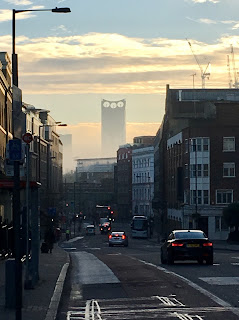On July 6 last year, I got on my bike for the last time outside my apartment building in Brooklyn. As I’d done hundreds of times before, I rode down Smith St and over the Manhattan Bridge to my employer’s office in west SoHo. Then, around lunchtime, I rode back, packed my bike into a box and headed with my family to JFK Airport. After an overnight flight to London, I did much the same as I’d done in New York in reverse. We headed to our temporary accommodation, I unpacked the bike and I rode to my employer’s London office.
 |
| A traffic jam on the Manhattan Bridge bike lane: a route I last took a year ago last week. |
That first ride in London after four years in New York was the start of a year in which it’s been a great privilege to rediscover the joys of getting around the UK by bicycle. Some of the more than 5,000 miles I’ve ridden have been for leisure. But I’ve also been rediscovering newspaper reporting by bicycle. I took my bike with me on a train to Manchester early on May 23, the morning after the appalling Manchester Arena bombing. I rode around Bradford during the general election campaign. On the night of June 3, I tried to cycle to London Bridge to investigate reports of an apparent terror attack, only to be stopped by panicky armed police officers ordering me to turn around.
Yet, as my enthusiasm for getting about by bike has reached still greater heights, I’ve found my enthusiasm for writing about it heading in the other direction. Writing on the issue that doesn’t fit the accepted narratives of people who oppose or support cycling provokes extraordinary levels of anger, I’ve discovered.
 |
| London from Parliament Hill: a joy to rediscover by bike |
Some of my posts have excited hostility from opponents of cycling. Two of my Facebook friends were so furiously resistant to the idea that drivers pose more danger to pedestrians than pavement (sidewalk) cyclists that they’re no longer my Facebook friends. But several others have inspired near-apoplexy among my fellow cyclists. The nadir of this was when one of the UK’s most respected cycle campaigners attributed my previous post to my alleged “cyclophobia”.
The problem is partly, I recognise, that this blog has always rather uncomfortably straddled twin roles as a platform for campaigning and philosophising. I’ve long believed, on one hand, that the bicycle is an excellent means of urban transportation, hoped to see more people riding bikes and supported the building of facilities that will make that possible. I’m personally slightly fanatical about trying to get around by bike whenever I can. When travelling with the prime minister to this weekend’s G20 summit, for example, I tried to find out if there was a way to park my bike at Heathrow Airport’s Royal Suite (there sadly wasn’t).
 |
| Me as I prepared to take my bike to Bradford for a general election piece: this is what a cyclophobe looks like, apparently |
But I’ve also spent nearly 10 of the last 14 years as a reporter writing about transport issues. I’m used to meeting the people facing the daunting challenge of devising transport systems that fulfill the needs of people that want to use buses and trains as well as bicycles. While I’ve sought to frame my pieces here in the context of a cyclist’s experience, I’ve ended up writing a fair amount with the perspective of someone caught up in the wider transport debate.
The bottom line is that it’s become so exhausting dealing with hostile reactions to my blogposts that it’s detracting from my enjoyment of cycling, rather than adding to it. I’m consequently making this my last post on this blog.
As with any break-up, I should explain the ways it’s not you but I who’s at fault. On April 18, I moved from writing about transport to covering politics full-time. The shift has meant both that my head’s been a lot less full of transport policy than it used to be and that my time has been consumed with other things. I’ve been thinking about, say, the messages of the main parties’ campaign literature in the recent snap UK general election rather than how patterns of demand for transport in London are changing.
While it was a joy for the piece on campaign literature to ride my bike to the north London constituency of Hampstead & Kilburn to research it, my mind was dwelling on politics as I headed home. I might once have pondered the relative merits of Royal College St’s segregated bike paths and the quiet, backstreet routes I used elsewhere.
 |
| Election literature I picked up after riding to Hampstead: a new preoccupation. |
My enthusiasm for blogging hasn’t been enhanced by the sheer intensity of the UK’s recent news flow. Since April 18, the country has not only experienced an extraordinary general election but two terror attacks - both of which I’ve been involved in covering - and the tragic Grenfell Tower fire. Issues around cycle infrastructure remain important but have felt less pressing in these circumstances.
Yet a row I had with two fellow cyclists on June 16 encapsulates a wearying tendency on both the roads and the internet that has played a significant part in putting me off. I encountered the pair near the exit from Kensington Gardens, in west London, as I rushed to Kensington Town Hall to cover the building’s occupation by protesters angry at Kensington & Chelsea council’s mishandling of the aftermath of the Grenfell Tower fire. On a section of the route where cyclists were asked to dismount, I did so. But, being in a hurry, when I passed the dismount sign at the other end of the narrow section, I got back on my bike and tried to continue my journey.
 |
| Police stop protesters from entering Kensington Town Hall: I had a telling experience en route to this event. |
The two other cyclists were having none of it. Having failed to spot the signs telling us to remount, they kept pushing their bikes, two abreast, down the middle of the path, deliberately obstructing me from getting past. When I finally got past, one of them said to me, “Try reading the signs next time”. It immediately struck me how common such behaviour is both on the roads and online. People who are sure of their own position are prone to assuming those who act differently from them are acting out of either stupidity or malice. People have been free in attributing elements of my posts on here to both.
The frustration is all the greater because much of the anger has been motivated by my determination to make clear a single point on which most London cycle campaigners have chosen to ignore what seems to me crystal-clear evidence. It’s become conventional wisdom among London cycle campaigners to insist that the construction and opening of the east-west, north-south and Vauxhall Bridge cycleways last year had no effect on motor vehicle congestion. It’s become fashionable, among other things, to blame London’s evident growing traffic jams on extra numbers of for-hire vehicles, rather than the effects of the reduced road capacity.
 |
| The North-South Superhighway on Blackfriars Bridge, before the latest barriers went up: useful, but not quite the way that Transport for London spins it. |
Yet there remains, it seems to me, no room for honest doubt about what’s going on in central London. Motor traffic volumes for the most recently reported quarter were down 3.4 per cent year-on-year, while average traffic speeds in the same period declined 5.4 per cent. The picture of growing congestion resulting from a shrinking of the road network’s capacity is obvious to nearly everyone outside cycle campaigning who looks at London traffic issues. That the building of the cycle superhighways has contributed significantly to the congestion is obvious from Transport for London’s report on implementation of the Cycle Superhighways, which shows eastbound journey times in the peak along the Embankment are up by 15 minutes.
The reactions I’ve received to pointing to these clear, unequivocal figures vary. A handful of people have thanked me for being willing to follow the data wherever they point. But the vast majority have involved some version of accusing me of stupidity, ill-will or a failure of imagination. Many people point to one of Transport for London’s arguments in favour of the cycle tracks - that Blackfriars Bridge now at rush hour carries more people than it did before the cycle tracks were installed. That, I think, misses the point about what’s uniquely useful about London’s roads - that much of the traffic now doesn’t involve passenger transport but deliveries, including traffic to and from the Crossrail building work, supplies for housebuilders and even the material needed to construct new segregated cycle superhighways. It also misses the point that many London roads are now congested and busy with motor traffic all day, while the peaks on the cycle tracks are far shorter.
Other critics have suggested that congestion is somehow inevitable - an argument that doesn’t fit with its having been successfully reduced by the introduction of the congestion charge in 2003. Some have welcomed the congestion because it will force people to take up cycling - an argument that I suggest won’t be much comfort to a relative of anyone stuck in an ambulance trying to get to hospital. Others have suggested that delays to buses - on which there are 6.5m daily trips - are a price worth paying for improving conditions for cyclists.
 |
| My son on the east-west Cycle Superhighway: finally, central London routes that are a joy to use with children |
I remain delighted that the cycle superhighways, which I use daily and which have made it far easier for me to get around central London by bike on my own and with my children, have been built. I am excited daily by the huge numbers of cyclists that I see heading down Clapham Road or over Vauxhall Bridge on my commute. But I continue to worry that, as long as so many London cycling activists cling to views about the dynamics of London’s congestion that defy the evidence, progress on further improving London’s cycling conditions will be slow. Some long-standing transport professionals whom I know - one of whom has been a long-term champion of cycling - now fear to discuss London cycling because of the poisonous atmosphere around this debate.
I would much prefer cycling activists to accept that the superhighways have exacerbated congestion that was already worsening. I'd hope people would then campaign for a more sophisticated, London-wide road-charging system that would deter driving in London far more effectively than the present congestion charge.
Anyone who begins from the starting point of believing the evidence of the statistics about trends in central London traffic is generally branded an unreliable cyclist-hater, however. There's normally some insinuation that the person is in the pocket of some sinister vested interest. It was, needless to say, in a discussion over London congestion statistics that I was accused of cyclophobia.
My clearest conclusion after a year back in the UK is that my efforts to analyse what’s going on around me and argue for my approach are doomed. I’ve made my case to scores of commenters on this blog and to still more people on Twitter and Facebook. My efforts have generated far more tension and unhappiness than they have understanding. It’s time to draw the inevitable conclusion from these failures and to stop trying.
There are sensations and experiences I’d like to express. I still enjoy remembering how Kennington Park Road, one of my regular haunts, was originally a Roman road. I like to think of how Roman soldiers marched there millennia ago. I’ve got faster at cycling over the past year, partly because I’ve lost 15kg. I’ve gained a new, childlike appreciation for the joys of speed on a bike. On the morning after the Manchester bombing, I left home before 6am and experienced for the first time in years the strange excitement of riding through dawn-time London as the corner shop shutters clank open.
 |
| My daughter and our bikes on the Emirates Air Line: she's played a role in some of my fondest cycling memories. |
Some of my strongest feelings involve riding with my daughter, who’s now 15. She has become far fitter as a cyclist, having started cycling daily to and from school. Eight days ago, I was rushing home with her by bike from the Tate Britain when we came on a group of adult cyclists who were riding more slowly than we were. In its own way, it was one of my most perfectly satisfying experiences on a bike to look round, ask her, “Are you ready?” and watch as she accelerated smoothly past them, a picture of confidence on her smart red road bike.
But, while I’ve enjoyed in the past mining such experiences to make points on this blog, it’s time now to work on a different discipline. I’m going to try harder to enjoy the daily joys of riding a bicycle in the moment, while forgetting the frustrations more quickly. I thank those who’ve read this blog regularly over the years and trust that you will nurture that joy a little more too.

























